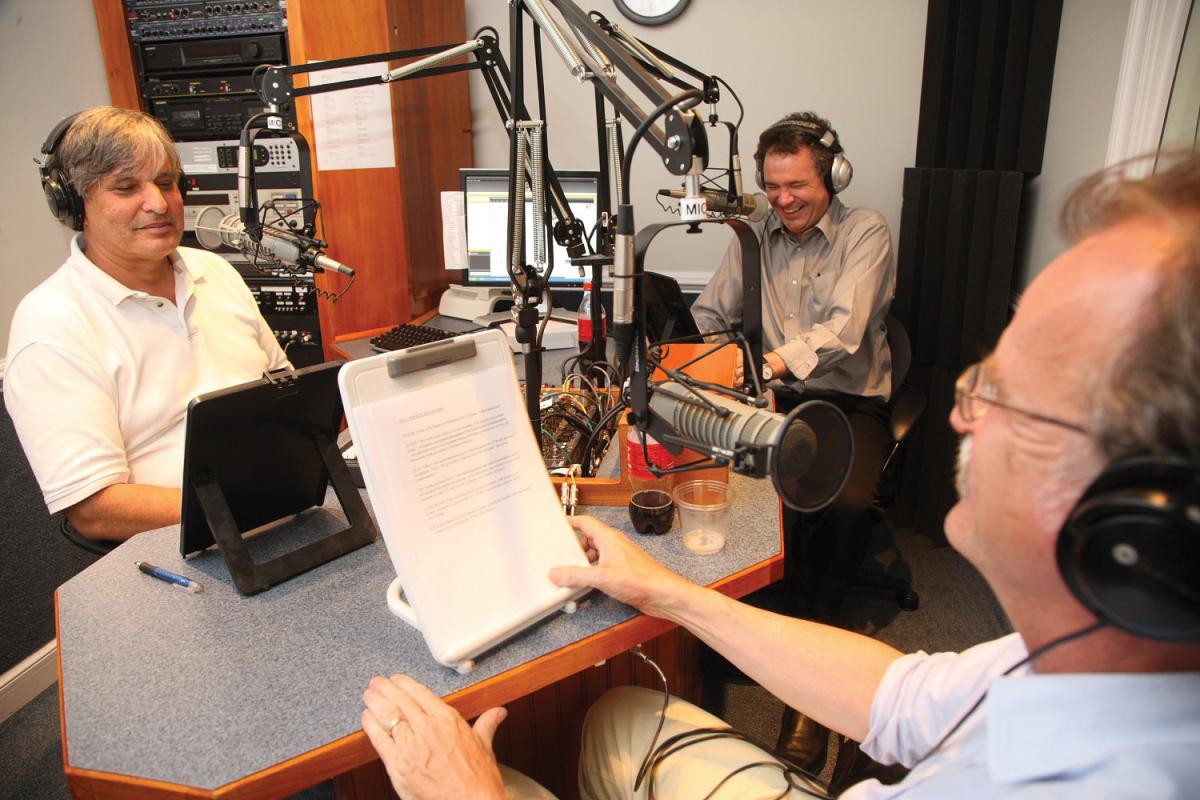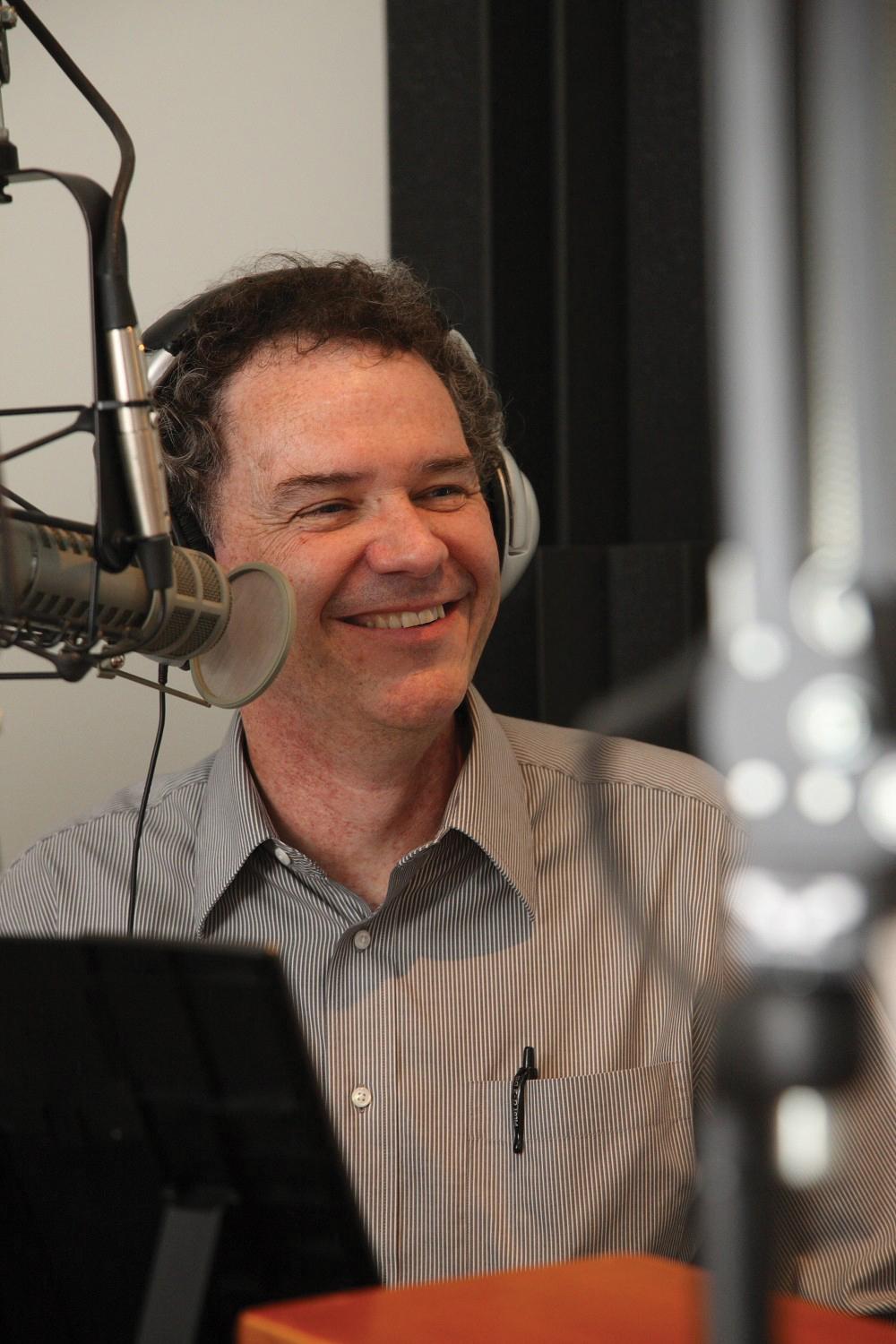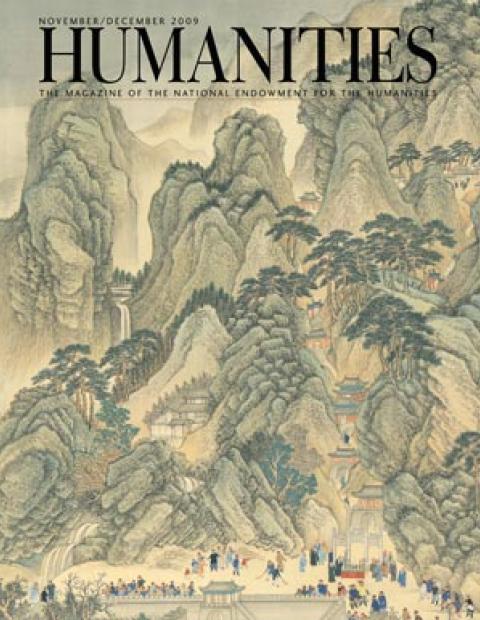If you’d asked historians Brian Balogh, Peter Onuf, and Ed Ayers five years ago how they’d feel about becoming popular radio personalities, they would have laughed it off as a joke. Well, in fact, someone did ask, and they did laugh. Heartily.
At the time, all three were employed at the University of Virginia; they were accomplished Ivy League-educated colleagues who collectively had penned enough books to fill a small library and garnered enough honors—academic and literary—to wallpaper any remaining walls in that library.
But host a radio show?
“I thought it was crazy,” laughs Ayers, now president of the University of Richmond in Virginia’s state capital.
“I don’t think history is funny!” Onuf says he replied when the idea for what would become BackStory with the American History Guys was first floated past him following a history symposium at which he and Ayers had presented.
And Balogh says the idea seemed so terrible at first that, in a strange way, he couldn’t resist.
“It was pitched in a way that made me laugh and convinced me it would never work,” he recalls, admitting he agreed only because it sounded like it would be fun—at least until it failed. “How bad could it be to sit around and talk about history?” he wondered.
It just goes to show that even the brightest among us can be wrong.
Since the first episode aired in June 2008 on a single station, the show has racked up rave reviews and awards from arts organizations including the Federation of State Humanities Councils and Public Radio Exchange. It was even singled out on iTunes as a “staff favorite.” More significantly, it’s built an ever increasing listenership. The show’s July 4 episode, “Independence Daze,” aired on twenty-seven public radio stations from Cape Cod to Sioux City to San Francisco, and introduced listeners to the history behind America’s most patriotic holiday and the traditions that accompany it.
If the show’s executive producer has his way, the “guys”—Onuf is “Eighteenth-Century Guy,” Ayers is “Nineteenth-Century Guy” and Balogh is “Twentieth-Century Guy”—will soon be on air weekly in all fifty states, bantering, interviewing prestigious intellectuals and common folk, taking calls from listeners, and, most importantly, says Onuf, “having a ball.”
The show’s success has been surprising even to the man who first envisioned it as he was exploring opportunities in radio programming at the Charlottesville-based Virginia Foundation for the Humanities in the fall of 2004.
“I knew both Ed and Peter,” says Andrew Wyndham, director of media programs at VFH and BackStory’s executive producer. “They’re both brilliant guys,” he says, “and I thought, if these two came together, we could have the makings of an extraordinary radio show, given their chemistry.”
After some initial good-humored resistance, in the summer of 2005 Ayers and Onuf agreed to give the show a try, but with one caveat.
“They both said we need a third guy who will be our twentieth-century expert,” Wyndham recalls. Ayers and Onuf already had that expert in mind: their UVA history department colleague and Ayers’s basketball buddy, Brian Balogh.
“I was a little worried about having three voices,” Wyndham admits, but when Balogh arrived for a meeting with Ayers, Onuf, and Wyndham to discuss the idea, “it was obvious that they really set off each other’s energy—it was happening right there in front of me,” Wyndham says. “They were making quips, coming up with ideas, generating thought after thought.”
Settling on the show’s hosts, however, would prove to be the lowest hurdle to leap as the four worked to take the concept from inception to airwaves.
By spring 2006, they’d created a thirty-minute history show demo called The History Guys featuring questions from callers and several regular segments including “Gear from Yesteryear,” examining technology and tools from the past, and “Kidding Around with History,” featuring children and teens excelling in history. That demo won them their first grant—$30,000 from UVA alumni through the office of UVA’s president. A year later, an expanded one-hour demo reaped even more money—$130,000 from another UVA fund, plus several individual donations.
But when they submitted the demo to various public radio stations for feedback, the reception, Wyndham says, wasn’t as warm.
“They came back to us and said, ‘There’s potential here, but it’s not there yet.’” Among the suggestions from that survey: that each episode needed a coherent theme and that the three hosts needed to “differentiate.” That wasn’t all.
“The biggest suggestion was to have a dedicated staff of people who have experience in producing shows and who can make this sing,” says Wyndham, who raised enough money to hire three fulltime radio professionals, including the show’s producer, Tony Field, in early 2008.
“The challenge with these guys has been working with them to find their voice as radio professionals instead of as professors,” says Field, who’d been an associate producer at On the Media, a one-hour National Public Radio show offering media criticism and analysis. Since his hiring, Field also has worked to develop a vibrant and interactive web presence for the new show at backstoryradio.org. But there’s a flip side to that challenge as well.
“A lot of exciting opportunities have presented themselves because of that,” says Field, explaining that many of the intellectual powerhouses Onuf, Ayers, and Balogh invite on the show are lured in by the idea of being interviewed by fellow scholars in place of traditional journalists or radio hosts.
“There’s a little more spontaneity and a little more seriousness” in the interviews, says Yale history professor David Blight, an authority on the U.S. Civil War and an old friend of Ayers and Balogh’s. Blight’s interview on the “Independence Daze” episode covered Frederick Douglass’s famed 1852 Fourth of July speech in which the freed slave offered his audience the scathing reminder that, because of his skin color, “the Fourth of July is yours, not mine.”
The three hosts of BackStory “are taking talk radio and TV culture,” says Blight, “and infusing it with some serious historical understanding.”
Which isn’t to say the guys understand everything. In that July 4 episode, a caller asks why Russian composer Tchaikovsky’s 1812 Overture is associated with the American holiday.
“We looked at each other, pointed at each other,” says Balogh, admitting the question stumped all three. “We don’t pretend to be experts on everything under the sun,” he notes, “and that seems to satisfy the caller, even if we can’t satisfy with specificity.” (In fact, Balogh quickly discovered, it was a July 4, 1974, performance of the overture by the Arthur Fiedler-conducted Boston Pops Orchestra, accompanied by fireworks, that sparked the tradition.)
Although the history of holidays have anchored several BackStory episodes, other episodes take a “ripped from the headlines” approach. In the past year, topics have included the timely “Panic! A history of Financial Crisis,” “From Whales to Wind: A History of Energy,” and “The More Things Change: The History of Presidential Transitions.”
But all three say the less of-the-moment topics have entertained them equally.
For Ayers, it was a surprise caller during their Mother’s Day program.
“They said, ‘It’s Billie from Kingsport, Tennessee,’” laughs Ayers. He admits it took him a moment to realize that the caller who asked, “What do three men know about motherhood, anyway?” was Ayers’s own octogenarian mother, a retired teacher, who then discussed with the guys the merits of mothers working versus staying at home.
In the course of that program, the guys addressed a question from another caller, who was planning to conceive, and wondered when the societal pressure to be a perfect mother began. For the record, the guys agree that the pressure likely started in the nineteenth century, when a mother’s role was essentially that of a “proto-Harvard business school”—raising boys into men who would be leaders in society. Girls, the guys noted, also needed an education so they would later be able to raise their own accomplished sons.
During the show’s Memorial Day episode on the history of death and mourning, Ayers says, he visited a very special grave site: his own, a plot set aside in Richmond’s historic Hollywood Cemetery for deceased presidents of the University of Richmond.
“That’s what I like about the show,” says Ayers, a Yale graduate with a Tennessee twang. “It doesn’t take itself too seriously.”
Balogh, too, holds one show at least slightly above the rest: the Thanksgiving program in which he interviewed his sports idol, 1970s Dallas Cowboys legend Roger Staubach, to find out what it was like to have spent a decade of Thanksgivings on the gridiron. “I don’t get to interview Roger Staubach every day,” he notes.
For Onuf, the joy of interviewing guests is at least matched by the pleasure of the studio repartee, a pleasure that’s obvious as the three men banter during a summer recording session, ribbing each other over whose century is superior until a producer reins them in.
“The thing I love most is when we surprise each other, including ourselves, with something weird, off-the-wall, some weird angle,” Onuf says. “The times when we’re doing our chops as historians. There’s that kind of excitement.”
Those “chops” are on display in the January 2009 episode, “Black & White: The Idea of Racial Purity,” when Balogh asks his two cohosts about the origins of the concept of race.
They trace it from the seventeenth and eighteenth centuries, when ethnicity was a far more powerful defining force than race, through slavery and emancipation, and on into the twentieth century. They discuss the 1967 Supreme Court decision in Loving v. Virginia, which declared antimiscegenation laws unconstitutional, and note that themes of racial identity became increasingly common in works by twentieth-century authors, including William Faulkner and George Orwell.
Yet for all the intellectual stimulation the show offers its hosts, it places grueling demands on their time, particularly considering all three men are already gainfully employed; eight to ten hours of studio recordings are edited to fit into each one-hour episode. And there have been several times when it appeared the show, despite its promise, might have become history itself.
In July 2007—as they were struggling with how to retool the show’s format—Ayers assumed the presidency at the University of Richmond following his tenure as dean of UVA’s School of Arts and Sciences. The move and long hours the new job would entail threatened to derail the fledgling radio program. Onuf soon chimed in with some good news of his own: He’d been offered a visiting professorship at Oxford University in England.
“I really thought that might be it,” says Wyndham.
Then, in stepped what might be considered “Twenty-first-Century Guy”—technology.
Setting up home sound studios for Onuf in England and Ayers in Richmond allowed recording to continue. Nearly two dozen shows later, Balogh says, “I’ve been surprised at how easily we adapted to being in three different places.”
And with Onuf now returned from his year overseas and Ayers just an hour away from the show’s Charlottesville home base, the future of BackStory, says Wyndham, looks especially bright.
Various grants and donations have allowed the show to meet its current $244,000 annual budget, and the guys are gearing up to take the show on the road. In June, they recorded before a live audience in Charlottesville, and recorded in Concord, New Hampshire, in September.
Wyndham hopes the show will run weekly by summer 2010 and that they’ll be able to convince the fifty-five stations that have already carried at least one episode to sign on permanently, although he acknowledges the current economic climate means meeting that goal won’t be a cakewalk. “It’s a tough time to be breaking in a new show in public radio,” he sighs.
For their parts, Balogh, Onuf, and Ayers seem to have made peace with their unexpected success—even as the show’s growth may put increasing demands on their already limited time.
“I put that in the ‘trouble in paradise’ category,” says Balogh.
Five years after they were first asked what seemed to be a silly question, indeed, they are well on their way to becoming radio stars. And, to their great delight, all three guys are still laughing.






